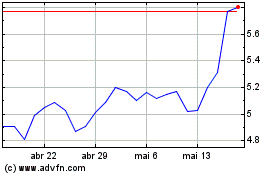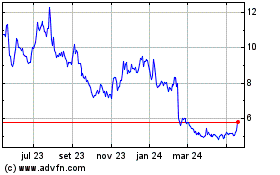New Guidelines Presented at ACR Convergence 2024 Recommend
First-Line Therapy with LUPKYNIS® (voclosporin) as Part of a Triple
Immunosuppressive LN Treatment Regimen
Aurinia Pharmaceuticals Inc. (NASDAQ: AUPH) (Aurinia or the
Company) commends the American College of Rheumatology (ACR) for
their 2024 evidence-based guidelines for the screening, treatment,
and management of lupus nephritis (LN), which prioritize the urgent
need to use efficacious treatments to avoid nephron loss and
preserve kidney function.
The guidelines call for a triple immunosuppression treatment
regimen for LN, with first line use of advanced therapies like
LUPKYNIS for three to five years. Importantly, the guidelines
suggest that steroids should be rapidly tapered to <5 mg/day by six months as the highest
acceptable maintenance dose of steroids. The guidelines also call
for achieving a proteinuria target of <0.5g/g urine protein creatinine ratio (UPCR)
by 12 months of treatment.
The recommendations included within the guidelines for use of
LUPKYNIS to treat LN were based on the AURORA Clinical Program,
including the Phase 3 AURORA 1 clinical study. In AURORA 1,
patients were 81% more likely to achieve a complete renal response1
at 52 weeks (40.8 vs 22.5 – OR 2.7) with LUPKYNIS in combination
with mycophenolate mofetil (MMF) and low-dose glucocorticoids,
compared to MMF and low-dose glucocorticoids alone. Additionally,
> 80% of patients were tapered to a steroid dose of <2.5mg / day by 16 weeks per the AURORA
protocol, making LUPKYNIS the only therapy to meet and exceed the
new guideline steroid target of <5mg /day by 6 months in randomized clinical
trials.
LUPKYNIS, the only FDA-approved CNI therapy for the treatment of
adult patients with active LN in combination with other
immunosuppressive therapies, has demonstrated broad clinical
utility across biopsy class, baseline eGFR, proteinuria range,
race, ethnicity, age, and gender. Please see Indication and
Important Safey Information, including Boxed Warning, below.
The guidelines recommend routine urine screening for proteinuria
at least every six to 12 months in patients with SLE without known
kidney disease, or when experiencing extra-renal flares. They also
conditionally recommend performing a kidney biopsy in patients with
SLE who have high levels of protein in the urine (> 0.5 g/g)
and/or impaired kidney function not otherwise explained.
“We applaud ACR’s critical and timely guidelines to improve the
management of lupus nephritis for this underserved patient
population. They provide clear guidance for the importance of early
diagnosis and starting with triple immunosuppression therapy with
CNIs like LUPKYNIS to help achieve a complete renal response and
aid in preserving kidney function for adults living with lupus
nephritis,” said Dr. Greg Keenan, Chief Medical Officer at
Aurinia.
The updated ACR guidelines for the diagnosis and treatment of LN
are based on systematic evidence reviews, feedback from a panel of
people living with LN, and input from rheumatologists and
nephrologists.
About LUPKYNIS
LUPKYNIS is a novel, structurally modified calcineurin inhibitor
(CNI) with a dual mechanism of action, acting as an
immunosuppressant through inhibition of T-cell activation and
cytokine production and promoting podocyte stability in the kidney.
The AURORA Clinical Program, comprised of the AURORA 1 pivotal
trial and AURORA 2 extension trial, demonstrated the importance of
LUPKYNIS plus standard of care to preserve kidney health in
patients with active LN without reliance on chronic high-dose
glucocorticoids. It is the only clinical program to include three
years of LN treatment and follow-up with mycophenolate mofetil
(MMF) and steroids.
About Aurinia
Aurinia Pharmaceuticals is a fully integrated biopharmaceutical
company focused on delivering therapies to people living with
autoimmune diseases with high unmet medical needs. In January 2021,
the Company introduced LUPKYNIS® (voclosporin), the first
FDA-approved oral therapy dedicated to the treatment of adult
patients with active lupus nephritis. Aurinia is also developing
AUR200, a differentiated, potential best-in-class therapy for
autoimmune diseases that targets both BAFF (B-cell Activating
Factor) and APRIL (A Proliferation-Inducing Ligand).
INDICATION AND IMPORTANT SAFETY INFORMATION
INDICATION
LUPKYNIS is indicated in combination with a background
immunosuppressive therapy regimen for the treatment of adult
patients with active lupus nephritis (LN).
Limitations of Use: Safety and efficacy of LUPKYNIS have not
been established in combination with cyclophosphamide. Use of
LUPKYNIS is not recommended in this situation.
IMPORTANT SAFETY INFORMATION
BOXED WARNINGS: MALIGNANCIES AND SERIOUS INFECTIONS
Increased risk for developing malignancies and serious
infections with LUPKYNIS or other immunosuppressants that may lead
to hospitalization or death.
CONTRAINDICATIONS: LUPKYNIS is contraindicated in
patients taking strong CYP3A4 inhibitors because of the increased
risk of acute and/or chronic nephrotoxicity, and in patients who
have had a serious/severe hypersensitivity reaction to LUPKYNIS or
its excipients.
WARNINGS AND PRECAUTIONS
Lymphoma and Other Malignancies: Immunosuppressants,
including LUPKYNIS, increase the risk of developing lymphomas and
other malignancies, particularly of the skin. The risk appears to
be related to increasing doses and duration of immunosuppression
rather than to the use of any specific agent.
Serious Infections: Immunosuppressants, including
LUPKYNIS, increase the risk of developing bacterial, viral, fungal,
and protozoal infections, including opportunistic infections which
lead to serious, including fatal outcomes.
Nephrotoxicity: LUPKYNIS, like other calcineurin
inhibitors (CNIs), may cause acute and/or chronic nephrotoxicity.
The risk is increased when CNIs are concomitantly administered with
drugs associated with nephrotoxicity. Monitor eGFR regularly.
Hypertension: Hypertension is a common adverse reaction
of LUPKYNIS therapy and may require antihypertensive therapy.
Monitor blood pressure regularly.
Neurotoxicity: LUPKYNIS, like other CNIs, may cause a
spectrum of neurotoxicities: severe include posterior reversible
encephalopathy syndrome (PRES), delirium, seizure, and coma; others
include tremor, paresthesia, headache, and changes in mental status
and/or motor and sensory functions. Monitor for neurologic
symptoms.
Hyperkalemia: Hyperkalemia, which may be serious and
require treatment, has been reported with CNIs, including LUPKYNIS.
Concomitant use of agents associated with hyperkalemia may increase
the risk for hyperkalemia. Monitor serum potassium levels
periodically.
QTc Prolongation: LUPKYNIS prolongs the QTc interval in a
dose-dependent manner when dosed higher than the recommended lupus
nephritis therapeutic dose. The use of LUPKYNIS in combination with
other drugs that are known to prolong QTc may result in clinically
significant QT prolongation.
Immunizations: Avoid the use of live attenuated vaccines
during treatment with LUPKYNIS. Inactivated vaccines noted to be
safe for administration may not be sufficiently immunogenic during
treatment with LUPKYNIS.
Pure Red Cell Aplasia: Cases of pure red cell aplasia
(PRCA) have been reported in patients treated with another CNI
immunosuppressant. If PRCA is diagnosed, consider discontinuation
of LUPKYNIS.
Drug-Drug Interactions: Avoid co-administration of
LUPKYNIS and strong CYP3A4 inhibitors or with strong or moderate
CYP3A4 inducers. Co-administration of LUPKYNIS with strong CYP3A4
inhibitors is contraindicated. Reduce LUPKYNIS dosage when
co-administered with moderate CYP3A4 inhibitors. Avoid use of
LUPKYNIS with strong or moderate CYP3A4 inducers.
ADVERSE REACTIONS
The most common adverse reactions (≥3%) were glomerular
filtration rate decreased, hypertension, diarrhea, headache,
anemia, cough, urinary tract infection, abdominal pain upper,
dyspepsia, alopecia, renal impairment, abdominal pain, mouth
ulceration, fatigue, tremor, acute kidney injury, and decreased
appetite.
SPECIFIC POPULATIONS
Pregnancy: Avoid use of LUPKYNIS.
Lactation: Consider the mother’s clinical need for
LUPKYNIS and any potential adverse effects to the breastfed infant
when prescribing LUPKYNIS to a lactating woman.
Renal Impairment: LUPKYNIS is not recommended in patients
with baseline eGFR ≤45 mL/min/1.73 m 2 unless benefit exceeds risk.
If used in this population, reduce LUPKYNIS dose.
Hepatic Impairment: For mild or moderate hepatic
impairment, reduce LUPKYNIS dose. Avoid use with severe hepatic
impairment.
Please see Prescribing Information, including Boxed Warning, and
Medication Guide for LUPKYNIS.
References
- 2024 American College of Rheumatology (ACR) Guideline for the
Screening, Treatment, and Management of Lupus Nephritis. Presented
November 18, 2024. Complete summary available at:
https://assets.contentstack.io/v3/assets/bltee37abb6b278ab2c/blt4db6d0b451e88caf/lupus-nephritis-guideline-summary-2024.pdf
- Rovin B et al. Efficacy and safety of voclosporin versus
placebo for lupus nephritis (AURORA 1): a double-blind, randomised,
multicentre, placebo-controlled, phase 3 trial. Lancet. 2021 May
29;397(10289):2070-2080. doi: 10.1016/S0140-6736(21)00578-X. Epub
2021 May 7.
________________________ 1 In the AURORA clinical program,
complete renal response is defined as UPCR of 0.5 mg/mg or less,
along with other criteria: stable renal function, defined as an
estimated glomerular filtration rate (eGFR) of at least 60
mL/min/1.73 m2, or no more than a 20% decrease from baseline in
eGFR; no rescue medication; no more than 10 mg prednisone
equivalent per day for at least 3 consecutive days, or 7 or more
days between weeks 44 and 52.
View source
version on businesswire.com: https://www.businesswire.com/news/home/20241118903839/en/
Media & Investor Inquiries: Andrea Christopher
Corporate Communications & Investor Relations Aurinia
Pharmaceuticals Inc. achristopher@auriniapharma.com
General Investor Inquiries: ir@auriniapharma.com
Aurinia Pharmaceuticals (NASDAQ:AUPH)
Gráfico Histórico do Ativo
De Fev 2025 até Mar 2025

Aurinia Pharmaceuticals (NASDAQ:AUPH)
Gráfico Histórico do Ativo
De Mar 2024 até Mar 2025
